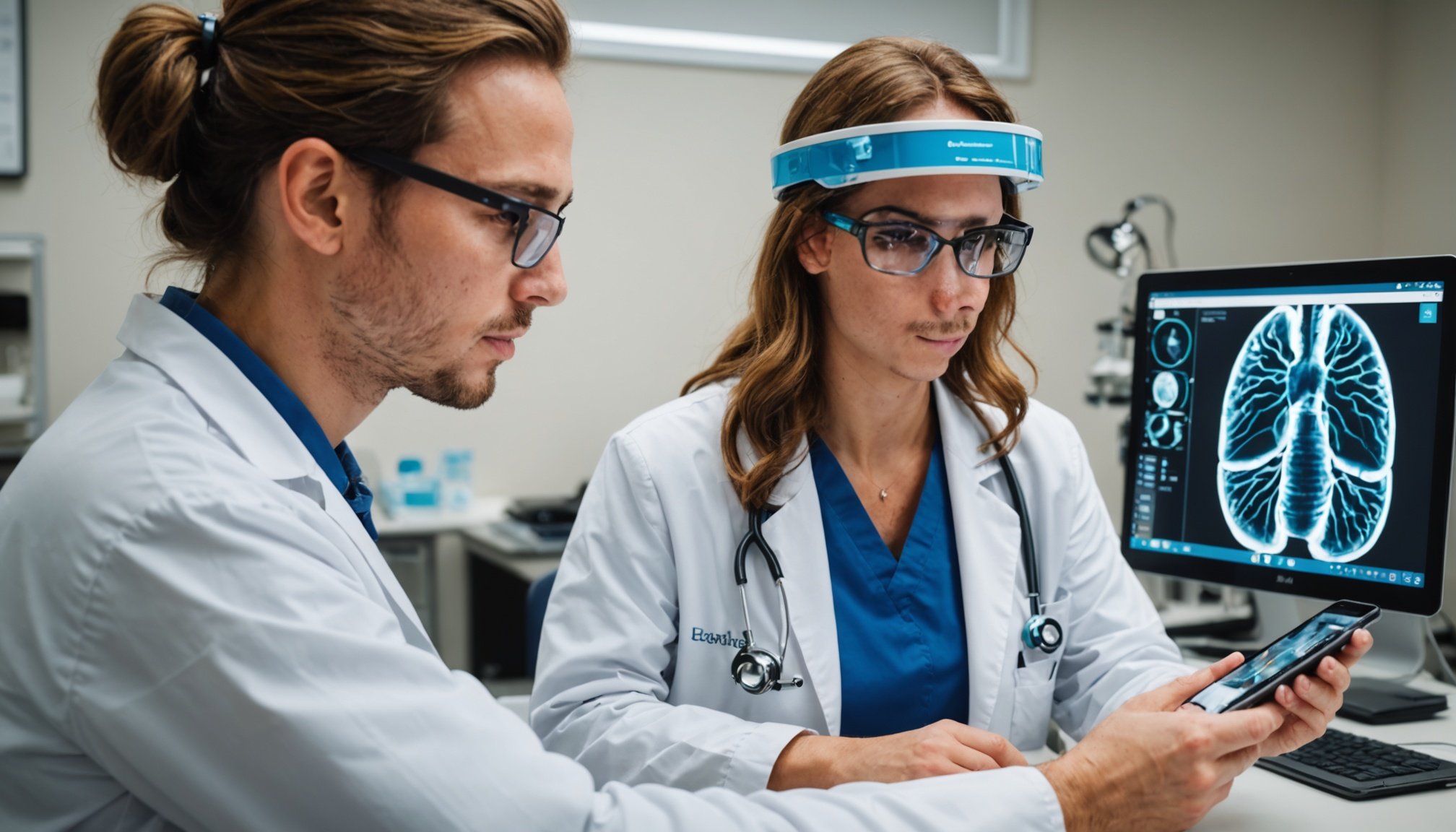Transforming Medical Education: How Augmented Reality is Shaping the Future of Healthcare Proficiency
The Evolution of Medical Education
Medical education has undergone significant transformations over the years, driven by advances in technology and the need for more effective and immersive learning experiences. One of the most promising innovations in this field is the integration of augmented reality (AR) and virtual reality (VR) into medical training. These technologies are revolutionizing the way healthcare professionals are educated, preparing them better for the complexities of real-world patient care.
Understanding Augmented Reality in Healthcare
Augmented reality adds digital elements to the real world, enhancing the learning environment by overlaying virtual information onto physical spaces. In the context of medical education, AR is particularly useful for real-time guidance during procedures and for providing detailed anatomical visualizations.
In the same genre : Elevating AI Performance: Cutting-Edge Strategies for Model Optimization in Low-Bandwidth Settings
Key Differences Between AR and VR in Healthcare
While both AR and VR enhance learning, they serve different purposes:
- Augmented Reality (AR): AR is often used for real-time guidance in procedures, allowing students to see virtual anatomical structures or instructions superimposed on real patients or models. This technology is invaluable for training in areas like surgery, where precision and real-time feedback are crucial[2].
- Virtual Reality (VR): VR immerses users in a fully virtual environment, allowing them to practice procedures in a simulated setting. This is particularly beneficial for high-risk procedures where the stakes are high, and mistakes can be costly[2].
Immersive Learning Environments
One of the most significant advantages of AR and VR in medical education is their ability to create immersive learning environments. These environments simulate real-world medical scenarios, enabling students to interact with virtual patients and practice procedures in a controlled, risk-free setting.
Have you seen this : Creating a Powerful AI Infrastructure for Seamless Big Data Handling: The Definitive Handbook
Benefits of Immersive Learning
- Hands-On Experience: AR and VR provide hands-on experience that bridges the gap between theoretical knowledge and practical application. Students can practice surgeries, emergency interventions, and other complex procedures without the risk of harming real patients[1][2].
- Enhanced Retention and Engagement: Studies have shown that immersive learning experiences significantly improve information retention and student engagement. By engaging multiple senses, AR and VR ensure that learners retain more information compared to traditional methods[1].
Enhanced Anatomical Understanding
AR and VR offer detailed and interactive 3D visualizations of human anatomy, which is a significant advantage over traditional textbooks and models.
Interactive 3D Visualizations
- Layer-by-Layer Exploration: Students can explore anatomical structures layer by layer, gaining a deeper and more comprehensive understanding of the human body. This level of detail is challenging to achieve with traditional teaching methods[1].
- Real-Time Feedback: AR and VR technologies provide immediate feedback and assessment during training sessions. Instructors can monitor students’ performance in real time, offering constructive criticism and guidance to help them improve[1].
Safe Practice for High-Risk Procedures
Practicing high-risk procedures on real patients can be daunting and dangerous. AR and VR offer a safe alternative, allowing students to perform complex surgeries and emergency interventions virtually.
Examples of Safe Practice
- Surgical Training: Institutions like AIIMS in India use VR for neurosurgical training, allowing students to practice intricate procedures in a simulated environment. This practice helps build proficiency and confidence, ensuring that learners are well-prepared when they perform these procedures on real patients[2].
- Emergency Medicine: AR can be used to simulate emergency scenarios, such as cardiac arrests or trauma cases, allowing students to practice their response in a controlled environment[2].
Collaborative Learning Opportunities
Healthcare is a team-based profession, and effective communication and collaboration are essential. AR and VR facilitate collaborative learning by allowing multiple students to interact within the same virtual environment.
Team-Based Learning
- Virtual Teamwork: Students can work together on patient cases, practice teamwork, and develop critical communication skills. These experiences foster dedicated team dynamics and prepare them for the collaborative nature of clinical practice[1].
- Real-Time Interaction: AR and VR enable real-time interaction among team members, simulating the real-world scenario where healthcare professionals must communicate effectively to provide optimal patient care[2].
Steps to Integrate AR and VR into Medical Curriculum
Integrating AR and VR into medical training requires a structured approach.
Assessing Readiness
- Infrastructure Requirements: Ensure the institution has good internet connectivity, AR/VR hardware, and adequate physical spaces for training. This initial assessment is crucial for a smooth integration[2].
Building a Structured AR/VR Curriculum
- Define Goals and Outcomes: Define specific goals, such as improving surgical accuracy or reducing diagnostic errors. Align these goals with learning outcomes to ensure measurable success[2].
- Combine Theory with Practice: Combine theoretical knowledge with immersive AR/VR simulations. For instance, a VR module on cardiac anatomy can complement classroom lectures[2].
Overcoming Challenges in AR and VR Integration
Despite the numerous benefits, integrating AR and VR into medical education comes with its challenges.
Addressing Costs and Accessibility
- Cost Considerations: The cost of AR and VR hardware and software can be prohibitive for some institutions. However, the long-term benefits in terms of improved learning outcomes and reduced training costs can justify the initial investment[2][4].
- Accessibility Issues: Ensuring that all students have access to AR and VR technologies is crucial. This may involve providing scholarships or subsidies for students who cannot afford the necessary equipment[4].
Training Faculty and Managing Resistance
- Faculty Training: Training faculty members to use AR and VR technologies effectively is essential. This includes workshops, training sessions, and ongoing support to ensure that instructors are comfortable using these tools[2].
- Managing Resistance: Addressing resistance to change is critical. This can be done by demonstrating the benefits of AR and VR through pilot programs and showcasing successful implementations[2].
The Future of AR and VR in Healthcare Education
The future of AR and VR in healthcare education is promising, with continuous innovation and adaptation expected.
Emerging Technologies
- Mixed Reality (MR): Mixed reality, which combines elements of both AR and VR, is also gaining traction. MR provides a more dynamic learning experience by changing how people interact with their surroundings. It can turn any location into a training facility and simulate real-world scenarios in a safe and controlled environment[4].
- AI-Driven Simulations: The integration of artificial intelligence (AI) into AR and VR simulations will further enhance the learning experience. AI can provide personalized feedback, adapt simulations to individual learning needs, and analyze large datasets to improve learning outcomes[3].
Practical Insights and Actionable Advice
For institutions looking to integrate AR and VR into their medical curriculum, here are some practical insights and actionable advice:
Key Takeaways
- Assess Your Readiness: Before starting, assess your institution’s readiness in terms of infrastructure, faculty expertise, and funding availability[2].
- Identify High-Impact Areas: Identify high-impact areas where AR and VR can make the most difference, such as surgical training or emergency medicine[2].
- Collaborate with Solution Providers: Collaborate with AR/VR solution providers to ensure you are getting the best technology and support for your needs[2].
Detailed Steps for Integration
- Current Assessment:
- Evaluate your institution’s current infrastructure and resources.
- Assess the faculty’s expertise and willingness to adopt new technologies.
- Determine the funding available for AR/VR integration.
- Infrastructure Requirements:
- Ensure good internet connectivity.
- Acquire necessary AR/VR hardware.
- Allocate adequate physical spaces for training.
- Identifying Use Cases:
- Determine which courses or training areas would benefit most from AR/VR.
- Focus on high-impact areas such as surgical training or emergency medicine.
- Building a Structured AR/VR Curriculum:
- Define specific goals and outcomes.
- Combine theoretical knowledge with immersive AR/VR simulations.
- Ensure real-time feedback and assessment during training sessions.
Quotes from Experts
Rebecca Cicero, Simulation Coordinator
“Simulation as a tool for learning and skill development has been transformative. Witnessing students gain confidence and proficiency through immersive simulations is incredibly rewarding. AR and VR are not just tools; they are game-changers in healthcare education,” says Rebecca Cicero, a seasoned professional in healthcare simulation[1].
Scholarly Perspectives
A systematic review published in the Journal of Surgical Research highlights that simulation-based training, including AR and VR, has become increasingly vital in surgical education. This review emphasizes that such training improves technical skills and provides comprehensive feedback, which is crucial for surgical proficiency[2].
Comparative Table: AR vs. VR in Medical Education
| Feature | Augmented Reality (AR) | Virtual Reality (VR) |
|---|---|---|
| Environment | Overlays digital elements onto the real world | Immerses users in a fully virtual environment |
| Use Cases | Real-time guidance during procedures, patient education | High-risk procedure practice, surgical training |
| Feedback | Real-time feedback during procedures | Immediate feedback and assessment during simulations |
| Accessibility | Can be used in various physical locations | Requires dedicated VR hardware and space |
| Learning Outcomes | Enhances anatomical understanding, improves procedural skills | Improves surgical accuracy, reduces diagnostic errors |
| Examples | AIIMS uses AR for patient education; Manipal Hospitals use AR for real-time procedural guidance[2] | AIIMS uses VR for neurosurgical training; Manipal Hospitals use VR for surgical simulations[2] |
The integration of augmented reality and virtual reality into medical education is a significant step forward in preparing healthcare professionals for the future. These technologies provide immersive, interactive, and highly effective training experiences that bridge the gap between theoretical knowledge and practical application.
As Rebecca Cicero aptly puts it, “AR and VR are not just tools; they are game-changers in healthcare education.” By embracing these technologies, institutions can ensure that their students are well-prepared to meet the demands of the ever-evolving healthcare landscape.
In the words of scholars from the Journal of Medical Internet Research, “The opportunities these technologies offer must be balanced against the associated challenges to ensure that digital medical education continues to thrive in the future”[3].
As we move forward, it is clear that AR, VR, and emerging technologies like mixed reality will continue to shape the future of healthcare education, making it more immersive, effective, and accessible.










